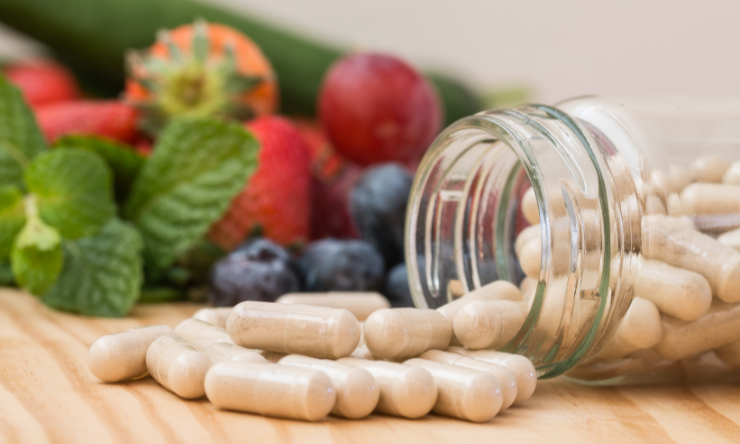Share
Given the convincing findings from the Age-Related Eye Disease Study (AREDS) on supplement recommendations in slowing down progression of age-related macular degeneration (AMD),1 it is not surprising that the role of diet and supplements has also been examined in glaucoma management. Many forms of dietary changes, vitamins and supplements have been investigated and this article will focus on the most prevalent ones.

Flavonoids (Gingko Biloba)
Flavonoids are a diverse group of plant-based compounds, commonly found in dark chocolate, red wine, citrus fruits, berries and tea.2,3 One of the more well-studied flavonoid-containing supplements, in the context of glaucoma management, is gingko biloba.
In human studies, ginkgo biloba appears to have beneficial effects on glaucoma with respect to both preventing progression and potentially improving performance on visual field testing. In 2003, Quaranta and colleagues5 published a double-blind crossover study, in which 27 patients with bilateral normal tension glaucoma (NTG) and progressive visual field defects were randomised to receive either placebo or gingko biloba extract for four weeks. These two groups were then washed out over eight weeks, and the treatments subsequently crossed over. Visual field testing was performed at baseline and then three times throughout the study – at the end of each treatment period, as well as at the end of the washout period.
While there were no significant differences in visual field from baseline after the placebo treatment, there were significant improvements after the use of gingko biloba supplements. The use of gingko biloba was well-tolerated with no ocular or systemic side effects.5
As per previous animal studies, this improvement in visual field appeared to be independent of IOP – no significant changes in IOP were noted throughout the entire study.5 The exact mechanism by which visual field improvement occurred was not clear but was thought to be due to either increased blood flow, improved cognitive function and concentration during visual field testing (via increased cerebral blood flow) or enhanced neuroprotection.5 Improvement in visual field had also washed out eight weeks after stopping gingko biloba use, indicating that long-term use of this agent is likely required to sustain the beneficial effect. Further longitudinal work is required to fully establish this. Nonetheless, gingko biloba certainly appears to offer some protective effect in glaucoma, particularly in potentially slowing down functional progression rate,9 and it is commercially available for easy access.
Carotenoids (Saffron)
Similar to the flavonoids, carotenoids are naturally occurring in many plants, and their unique pigment provides the yellow, orange and red colours in fruits, vegetables and flowers.3 The carotenoid agents, lutein and zeaxanthin, are also naturally occurring within the macular region, and the use of these as supplements in AMD has been well-documented.1
Saffron contains high concentrations of carotenoid derivatives (crocin and crocetin) and its antioxidative properties in glaucoma management were investigated in a double-blind randomised study conducted by Jabbarpoor Bonyadi and colleagues.6 Fifty patients with stable and medically-treated primary open angle glaucoma (POAG) were recruited and randomised to receive either saffron or placebo.
Patients who received saffron in the study achieved a mean reduction in IOP of 2mmHg by the end of the four week period (compared to no change in the placebo group), however IOP returned to baseline after one month of discontinuation.6 In addition to a small sample size and short follow-up period, there was still a relatively large standard deviation and range of IOPs in the saffron group. Higher concentrations of saffron can also induce more systemic adverse effects – less than 1.5 grams per day is generally thought to be safe, although some reports of vomiting, nausea and diarrhoea have been reported at this level. Toxicity has been reported at over five grams per day.6 Additionally, saffron is one of the most expensive spices in the world and in a lifestyle intervention pilot study conducted by Hecht and colleagues,7 incorporating the use of saffron among other lifestyle changes showed no significant reduction in IOP after four weeks. The clinical evidence for saffron is relatively weak and does not necessarily justify its cost, hence its use is generally not recommended as a supplement in glaucoma management.
Nicotinamide/Niacinamide (Vitamin B3)
Nicotinamide (also known as niacinamide) has recently shown significant potential as a novel treatment for glaucoma. It was postulated as a neuroprotective agent for glaucoma in 2017 by Williams and colleagues.8 In animal studies, they identified that mitochondrial dysfunction within the retinal ganglion cells was a key component in glaucoma development and progression. Nicotinamide adenine dinucleotide (NAD+) plays a critical role in maintaining mitochondrial health and is therefore inherently neuroprotective.
Following on from this, Hui and colleagues9 conducted a crossover randomised clinical trial, which showed significant improvement of visual field parameters and inner retinal function in patients treated with nicotinamide. This study recruited 57 patients with early-to-moderate glaucoma and randomised them to receiving either a placebo or nicotinamide (NAM) for 12 weeks. After 12 weeks, the two cohorts swapped treatments but followed the same dosing. Nicotinamide is the water-soluble version of Vitamin B3 and was commercially available at the time of the study.
While there were no statistically or clinically significant differences in IOP or visual acuity between the treated and control groups, a greater proportion of patients on high-dose NAM showed an improvement in visual field compared to the control group; similarly, fewer subjects demonstrated a reduction in visual field.9 Impressively, there was also significant improvement in inner retinal function on ERG testing in the high-dose NAM cohort compared to placebo, even after only 12 weeks of NAM supplementation. Further studies are underway to show if these improvements are sustained over time, but NAM shows promise as a treatment independent of IOP change which does not simply slow the rate of glaucoma progression but rather, may reverse disease and improve visual function.9
If you are considering taking vitamin B3, please consult your treating ophthalmologist before starting any medications to determine whether it is right for you. The dosage used in the clinical trials are higher than the recommended daily dose so it’s important that you first consult the health professionals involved in your care.
Vitamin B3 can also be found naturally in foods such as fish, poultry, red meat, nut/seeds and legumes and high dietary intake of these should be discussed.
Other Vitamins and Minerals
Other vitamins, such as Vitamins A, C, D and E, have been investigated in glaucoma management given their antioxidative and neuroprotective roles in other ocular and systemic diseases. However, these clinical trials and studies have generally been small-scale and have generated conflicting results with respect to whether they actually influence IOP or retard glaucoma progression.2,4,10 Certainly, there is evidence that diets rich in green, leafy vegetables (which contain high levels of nitrates and nitric oxide) are associated with reduced odds of glaucoma and this, in lieu of using vitamin supplements, should always be discussed and encouraged with patients.2,4
Essential Fatty Acids (Omega-3 and Omega-6)
The role of the essential fatty acids (EFA), omega-3 and omega-6, in glaucoma management is not well-established. These are known to play a role in modulation of blood flow and maintaining cellular health in the rest of the body.2 Some studies have identified that high consumption of EFAs may increase risk for POAG, while others have found a reduction in the IOPs of patients with pseudoexfoliative glaucoma and normal tension glaucoma.7
Caffeine
The link between caffeine, glaucoma risk and glaucoma progression has been tenuous at best.4 Some studies have detected small increases in IOP by 1-2mmHg for 90-120 minutes after coffee consumption.11,12 Consuming more than three to five cups of coffee a day does appear to be correlated with increased risk of developing glaucoma, particularly in certain sub-groups of patients – specifically, those with a positive family history of glaucoma and those with pseudoexfoliation syndrome.2,10,13 In patients with established POAG, excessive coffee consumption could be linked with increased risk of progression11 and it is therefore a good idea to moderate caffeine intake. Interestingly, the effect of hot caffeinated tea seemed to be different from coffee – tea generally contains less caffeine than coffee and has a higher concentration of flavonoids which, as previously discussed, may offer a protective effect against glaucoma.2
Alcohol
In a similar fashion to caffeine intake, the relationship between alcohol consumption and glaucoma is unclear, with some studies finding no association, others a negative effect and, in some cases, a positive effect (via dehydration and reduced aqueous production).2,4,12 The conflicting evidence in the literature likely relates to individualised tolerance and metabolism of alcohol,7 as well as the form of alcohol – for example, red wines such as Cabernet Sauvignon and Pinot Noir contain a high concentration of flavonoids.2 In the interest of general health, alcohol consumption in moderation is encouraged.
Conclusion
There is now a reasonably large body of literature relating to the effect of diet, nutritional supplements, exercise, concurrent medical conditions, and systemic medications on the risk of glaucoma development and progression. It remains difficult, however, to draw direct causal associations due to relatively small sample sizes in studies and, at times, conflicting evidence. Nonetheless, it is worth discussing the merits of a nutritious diet, supplements, moderate aerobic exercise, and good systemic health with your eye care professional, as these are all likely to have a positive effect on glaucoma management as well as general well-being. However, it should always be emphasised that IOP-lowering therapy remains the gold standard for glaucoma treatment. While certain nutritional supplements and lifestyle interventions have shown potential benefit in glaucoma management, they cannot replace the need for eye drops, laser or glaucoma surgery when indicated.
References
1. Chew EY, Clemons TE, SanGiovanni JP, Danis R, Ferris Iii FL, Elman M, Antoszyk A, Ruby A, Orth D, Bressler S, Fish G, Hubbard B, Klein M, Chandra S, Blodi B, Domalpally A, Friberg T, Wong W, Rosenfeld P, Agron E, Toth C, Bernstein P, Sperdut R. Lutein + Zeaxanthin and Omega-3 Fatty Acids for Age-Related Macular Degeneration: The Age-Related Eye Disease Study 2 (AREDS2) Randomized Clinical Trial. JAMA : the journal of the American Medical Association 2013; 309: 2005-15.
2. Perez CI, Singh K, Lin S. Relationship of lifestyle, exercise, and nutrition with glaucoma. Current opinion in ophthalmology 2019; 30: 82-8.
3. Chen C. Overview of Plant Pigments. In: Chen C. Pigments in Fruits and Vegetables Genomics and Dietetics, 1st ed. New York, NY: Springer New York; 2015. p1-7.
4. Fahmideh F, Marchesi N, Barbieri A, Govoni S, Pascale A. Non-drug interventions in glaucoma: Putative roles for lifestyle, diet and nutritional supplements. Survey of ophthalmology 2021.
5. Quaranta L, Bettelli S, Uva MG, Semeraro F, Turano R, Gandolfo E. Effect of Ginkgo biloba extract on preexisting visual field damage in normal tension glaucoma. Ophthalmology (Rochester, Minn) 2003; 110: 359-62.
6. Jabbarpoor Bonyadi MHo, Yazdani S, Saadat S. The ocular hypotensive effect of saffron extract in primary open angle glaucoma: a pilot study. BMC complementary and alternative medicine 2014; 14: 399.
7. Hecht I, Achiron A, Bartov E, Maharshak I, Mendel L, Pe'er L, Bar A, Burgansky-Eliash Z. Effects of dietary and lifestyle recommendations on patients with glaucoma: A randomized controlled pilot trial. European journal of integrative medicine 2019; 25: 60-6.
8. Williams PA, Harder JM, John SWM. Glaucoma as a Metabolic Optic Neuropathy: Making the Case for Nicotinamide Treatment in Glaucoma. Journal of glaucoma 2017; 26: 1161-8.
9. Hui F, Tang J, Williams PA, McGuinness MB, Hadoux X, Casson RJ, Coote M, Trounce IA, Martin KR, Wijngaarden P, Crowston JG. Improvement in inner retinal function in glaucoma with nicotinamide (vitamin B3) supplementation: A crossover randomized clinical trial. Clinical & experimental ophthalmology 2020; 48: 903-14.
10. Pasquale LR, Kang JH. Lifestyle, Nutrition, and Glaucoma. Journal of glaucoma 2009; 18: 423-8.
11. Hecht I, Achiron A, Man V, Burgansky-Eliash Z. Modifiable factors in the management of glaucoma: a systematic review of current evidence. Graefe's archive for clinical and experimental ophthalmology 2016; 255: 789-96.
12. Stewart WC. The effect of lifestyle on the relative risk to develop open-angle glaucoma. Current opinion in ophthalmology 1995; 6: 3-9.
13. Antón-López A, Moreno-Montañés J, Duch-Tuesta S, Corsino Fernández-Vila P, García-Feijoo J, Millá-Griñó E, Muñoz-Negrete FJ, Pablo-Júlvez L, Rodríguez-Agirretxe I, Urcelay-Segura JL, Ussa-Herrera F, Villegas-Pérez MP. Lifestyles guide and glaucoma (II). Diet, supplements, drugs, sleep, pregnancy, and systemic hypertension. Archivos de la Sociedad Española de Oftalmología (English ed) 2018; 93: 76-86.




